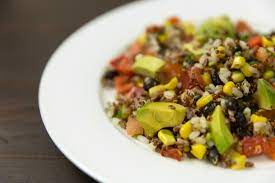Quinoa

What's the big deal with Quinoa?
These days almost everyone in the health and fitness industry are talking about Quinoa, only to find out that its a more expensive version of rice except extremely small compare to one grain of rice. So first we will clear up some confusion about this mysterious, yet nutrition packed plant based food.

Quinoa, is a herbaceous annual plant that’s grown mainly for its seeds and is well known for containing high amounts of protein, and fiber along with important vitamins and minerals. Vitamins and minerals like magnesium, potassium, calcium, vitamin E, iron, prosperous, copper, zinc and B vitamins can be consumed in just one serving of Quinoa.
Perfect for vegetarians, especially "Vegan Body- builders

The great part is that its perfect for vegetarians, especially “Vegan Body- builders” because its a complete protein with all 9 essential amino acids, where only one cup provides around 8 grams of protein.
One cup of Quinoa also has 39 grams of carbs, 6 grams of fat, 5 gams of fiber and 1 gram of sugar, with a total of 222 calories. Compared to brown rice, quinoa has less carbs in one cup, but carries more protein, healthy fat, fiber and overall calories. In my opinion brown rice and quinoa are great options for complexed carbohydrates. However, quinoa is better than brown rice because of the fact that its a complete protein and brown rice needs to be eaten with ‘another’ plant based food to get all 9 essential amino acids. As well as the fact that its gluten-free and a powerful plant based anti-oxidant.
Quinoa contains high amounts of quercetin and kaempferol that are well known flavonoids that have anti- inflammatory, anti- viral, anti- depressant and anti cancer effects that can help persons struggling with health complications, illness and disease.


According to one study from The Journal Council of Nutrition, dietary fiber found in whole grains may boost digestive health, lower bad cholesterol and lower the risk of some gastrointestinal cancers like colon cancer.
The World Journal of Diabetes published an article that explains the link between persons with type 2 diabetes and low levels of magnesium, and stated that adding quinoa to your diet can help improve magnesium levels in the body significantly. Most of the fiber found in quinoa is insoluble, but there’s still a whopping 2.5 grams of soluble fiber present in one cup and can therefore help lower blood sugar levels, and increased feelings of fullness, making it also great for weight loss. With a low glycemic index of 53, quinoa can be the perfect addition for persons with type 2 diabetes and heart disease.

They also found that the high levels of magnesium in quinoa has been linked to improved heart health and that persons who ate this super food regularly had a reduced risk of stroke.
Remember to soak Quinoa before cooking!
Quinoa has a coating of something called ‘phytic acid’ which impairs the absoption of nutrients like calcium, zinc and iron. So make sure to soak for 2 hours or over night, then rinse thoroughly before cooking. That way you can avoid experiencing unpleasant side effects like stomach irritation and enjoy the full, power packed benefits of this amazing whole grain food.
